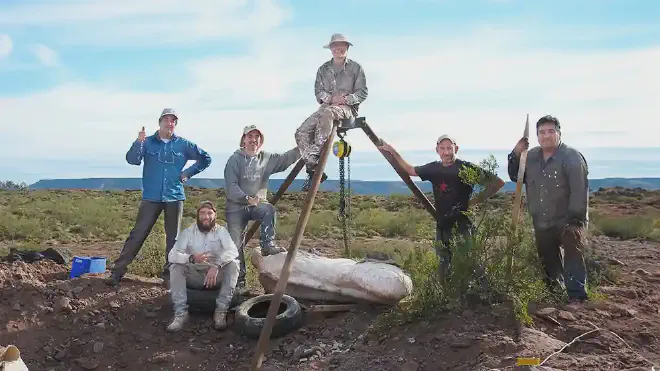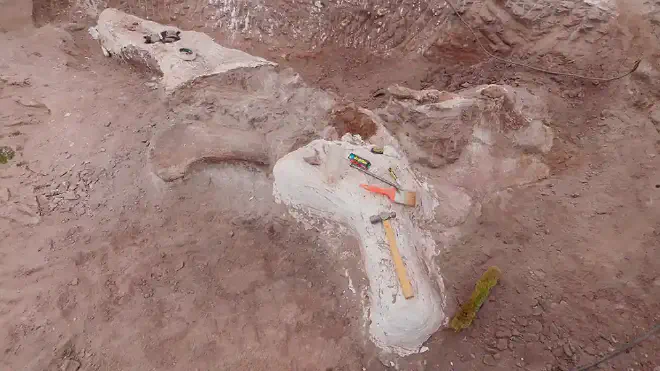

CONICET researchers, along with colleagues from other national institutions, discovered the fossil remains of a new dinosaur from the rebachisaurid family in the department of Añelo, Neuquén. This group of sauropod dinosaurs inhabited the region approximately 95 million years ago. The new species, named Astigmasaura genuflexa, was presented in the journal Cretaceous Research.
Astigmasaura was a herbivorous quadruped with a long neck and tail, measuring about 18 meters long and weighing more than 10 tons. Its tail vertebrae had very tall bony extensions, both upward and lateral. It had very diverse hemal arches—bones beneath the tail that protect the nervous and circulatory systems—including elongated and straight, boot-shaped, and star-shaped. It also had slender legs and toes that flared from front to back.
Flavio Bellardini, a CONICET postdoctoral fellow at the Institute for Research in Paleobiology and Geology (IIPG, CONICET-UNRN) and first author of the article, comments that this is the first time that the posterior part of a rebachisaurid dinosaur skeleton has been discovered, with both hind limbs, the hip, and the anterior half of the tail perfectly preserved, thus shedding light on some of the still poorly understood anatomy. He also emphasizes that Astigmasaura is one of the last species of rebachisaurid dinosaurs before their extinction some 90 million years ago, making it essential for reconstructing the final stages of the group’s evolutionary history, at least in Patagonia.

Thanks to the preservation conditions of the Astigmasaura bones, it was possible to reconstruct, for the first time, the anatomy of the hind legs and feet, as well as part of the musculature of the rebachisaurids. According to the paleontologists who led the discovery, this will serve as a basis for future studies, which will determine how they moved, their posture, and the type of footprints they might have left. Furthermore, the researchers found that some tail vertebrae exhibit pathologies and a particular ossification of the tendons, which would indicate the individual’s advanced age at the time of death.
Discovery and excavation #

“In 2017, a report of a chance find by oil workers at the GASNOC YPF El Orejano field led to the discovery of a nearly complete, articulated skeleton of this dinosaur from the lower levels of the Huincul Formation. These sandy and clayey levels, where the fossilized bones were found, corresponded to a section of a meandering river, which had a sinuous or curved, snake-like path, indicating that the remains, carried by a low-energy current, became stranded on one of the many sand bars that formed along its course. Over time, the neck, back, forelimbs, and the end of the tail were swept away by the current and did not fossilize. A rapid flood covered what remained with sediment, allowing the preservation of what today represents the type material of this new species of rebachisaurid sauropod dinosaur,” Bellardini explains.
The excavation required five paleontological campaigns and more than thirty days of fieldwork. During this time, sledgehammers, points, hammers, chisels, rotary hammers, jackhammers, and rock cutters were used to break the supporting rock. To properly transport the bones, eight gypsum and burlap sacks were assembled. The lightest of these were loaded onto pickup trucks using a tripod and a winch, while the heaviest, some weighing more than a ton, required the intervention of a backhoe and two trucks.

The CONICET paleontologist indicates that “in 2023, the last plaster lump was recovered from the discovery site and transferred to the _“Argentino Urquiza” Municipal Museum in Rincón de los Sauces. There, the preparation and cleaning of the material began, requiring months of laboratory work to free the fragile fossilized bones from the hard supporting rock. Finally, 20 caudal vertebrae, 19 haemal arches, both ischia, pubis, part of the ilium, 2 femurs, 2 tibias, 2 fibulas, 2 astragalus, and both almost complete feet were prepared.”
Citation #
BELLARDINI, F., FILIPPI, L., CARBALLIDO, J. É., GARRIDO, A., & BAIANO, M. (2025). Side by side with titans: a new rebbachisaurid dinosaur from the Huincul Formation (upper Cenomanian) of Patagonia, Argentina. Cretaceous Research, 106188. https://doi.org/10.1016/j.cretres.2025.106188
- The article Descubren en Neuquén una nueva especie de dinosaurio saurópodo que vivió hace 95 millones de años signed by Nahuel Aldir – Communications Department of the Institute for Research in Paleobiology and Geology (IIPG, CONICET-UNRN), was published in CONICET’s website.

